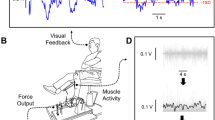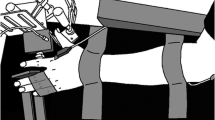Abstract
Purpose
The aim of the study was to evaluate the force control in the complete absence of visual feedback and the effect of repeated contractions without visual feedback.
Methods
Twelve physically active males (age 23 ± 1 years; stature 1.74 ± 0.07 m; body mass 71 ± 6 kg) performed isometric tasks at 20, 40 and 60 % maximal voluntary contraction (MVC) for 20 s. For each intensity, a trial with force visual feedback (FB) was followed by 3 trials without FB (noFB-1, noFB-2, noFB-3). During contraction, force and surface electromyogram (EMG) from the vastus lateralis muscle were recorded. From force signal, the coefficient of variation (CV, force stability index), the distance of force from target (ΔF, force accuracy index) and the time within the target (t-target) were determined. From EMG signal, the root mean square (RMS) and mean frequency (MF) were calculated.
Results
MVC was 679.14 ± 38.22 N. In noFB-1, CV was similar to FB, ΔF was higher and t-target lower (P < 0.05) than in FB. EMG-RMS in noFB-1 was lower than in FB at 40 and 60 %MVC (P < 0.05). A decrease in ΔF between noFB-1 and noFB-3 (P < 0.05) and an increase in t-target from noFB-1 to noFB-3 (P < 0.05) occurred at 20 % MVC. A difference in EMG-RMS among noFB conditions was retrieved only at 60 % MVC (P < 0.05).
Conclusions
These findings suggest that the complete absence of visual feedback decreased force accuracy but did not affect force stability. Moreover, the repetition of noFB trials improved force accuracy at low exercise intensity, suggesting that real-time visual information could be obviated by other feedbacks for force control.







Similar content being viewed by others
Abbreviations
- CV:
-
Coefficient of variation
- EMG:
-
Electromyographic signal
- F:
-
Mean force
- FB:
-
With visual feedback
- MF:
-
Mean frequency
- MVC:
-
Maximal voluntary contraction
- noFB:
-
Without any form of visual feedback
- RMS:
-
Root mean square
- SD:
-
Standard deviation
- t-target:
-
Time during which force was maintained within the target
- ΔF:
-
Distance of the force signal from the required target
References
Alkadhi H, Crelier GR, Boendermaker SH, Golay X, Hepp-Reymond MC, Kollias SS (2002) Reproducibility of primary motor cortex somatotopy under controlled conditions. AJNR Am J Neuroradiol 23(9):1524–1532
Athreya DN, Van Orden G, Riley MA (2012) Feedback about isometric force production yields more random variations. Neurosci Lett 513(1):37–41
Baweja HS, Patel BK, Martinkewiz JD, Vu J, Christou EA (2009) Removal of visual feedback alters muscle activity and reduces force variability during constant isometric contractions. Exp Brain Res 197(1):35–47
Christou EA (2005) Visual feedback attenuates force fluctuations induced by a stressor. Med Sci Sports Exerc 37(12):2126–2133
Christou EA, Jakobi JM, Critchlow A, Fleshner M, Enoka RM (2004) The 1- to 2-Hz oscillations in muscle force are exacerbated by stress, especially in older adults. J Appl Physiol 97(1):225–235
Dimitriou M, Edin BB (2010) Human muscle spindles act as forward sensory models. Curr Biol 20(19):1763–1767
Enoka RM, Burnett RA, Graves AE, Kornatz KW, Laidlaw DH (1999) Task- and age-dependent variations in steadiness. Prog Brain Res 123:389–395
Esposito F, Ce E, Rampichini S, Veicsteinas A (2009) Acute passive stretching in a previously fatigued muscle: electrical and mechanical response during tetanic stimulation. J Sports Sci 27(12):1347–1357
Flanders M (2005) Functional somatotopy in sensorimotor cortex. Neuroreport 16(4):313–316
Franklin DW, So U, Burdet E, Kawato M (2007) Visual feedback is not necessary for the learning of novel dynamics. PLoS One 2(12):e1336
Freund HJ (1983) Motor unit and muscle activity in voluntary motor control. Physiol Rev 63(2):387–436
Glickstein M (2000) How are visual areas of the brain connected to motor areas for the sensory guidance of movement? Trends Neurosci 23(12):613–617
Grodd W, Hulsmann E, Lotze M, Wildgruber D, Erb M (2001) Sensorimotor mapping of the human cerebellum: fMRI evidence of somatotopic organization. Hum Brain Mapp 13(2):55–73
Hamilton AF, Jones KE, Wolpert DM (2004) The scaling of motor noise with muscle strength and motor unit number in humans. Exp Brain Res 157(4):417–430
Harbst KB, Lazarus JAC, Whitall J (2000) Accuracy of dynamic isometric force production: the influence of age and bimanual activation patterns. Mot Control 4(2):232–256
Hu X, Loncharich M, Newell KM (2011) Visual information interacts with neuromuscular factors in the coordination of bimanual isometric force. Exp Brain Res 209(1):129–138
Jackson AW, Ludtke AW, Martin SB, Koziris LP, Dishman RK (2006) Perceived submaximal force production in young adults. Res Q Exerc Sport 77(1):50–57
Janczyk M, Skirde S, Weigelt M, Kunde W (2009) Visual and tactile action effects determine bimanual coordination performance. Hum Mov Sci 28(4):437–449
Kennedy DM, Christou EA (2011) Greater amount of visual information exacerbates force control in older adults during constant isometric contractions. Exp Brain Res 213(4):351–361
Krogh-Lund C, Jorgensen K (1993) Myo-electric fatigue manifestations revisited: power spectrum, conduction velocity, and amplitude of human elbow flexor muscles during isolated and repetitive endurance contractions at 30 % maximal voluntary contraction. Eur J Appl Physiol Occup Physiol 66(2):161–173
Laming AC, Martin FJ (1997) Right problem, wrong solution. Aust N Z J Ophthalmol 25(1):5–6
Latash ML, Scholz JF, Danion F, Schoner G (2001) Structure of motor variability in marginally redundant multifinger force production tasks. Exp Brain Res 141(2):153–165
Lee KM, Keller EL (2008) Neural activity in the frontal eye fields modulated by the number of alternatives in target choice. J Neurosci 28(9):2242–2251
Lin SI, Yang WC (2011) Effect of plantar desensitization on postural adjustments prior to step initiation. Gait Posture 34(4):451–456
Madeleine P, Jorgensen LV, Sogaard K, Arendt-Nielsen L, Sjogaard G (2002) Development of muscle fatigue as assessed by electromyography and mechanomyography during continuous and intermittent low-force contractions: effects of the feedback mode. Eur J Appl Physiol 87(1):28–37
Miall RC, Weir DJ, Stein JF (1985) Visuomotor tracking with delayed visual feedback. Neuroscience 16(3):511–520
Miall RC, Weir DJ, Stein JF (1993) Intermittency in human manual tracking tasks. J Mot Behav 25(1):53–63
Miall RC, Haggard PN, Cole JD (1995) Evidence of a limited visuo-motor memory used in programming wrist movements. Exp Brain Res 107(2):267–280
Milner AD, Goodale MA (1993) Visual pathways to perception and action. Prog Brain Res 95:317–337
Moritani T, Muramatsu S, Muro M (1987) Activity of motor units during concentric and eccentric contractions. Am J Phys Med 66(6):338–350
Newell KM, Broderick MP, Deutsch KM, Slifkin AB (2003) Task goals and change in dynamical degrees of freedom with motor learning. J Exp Psychol Hum Percept Perform 29(2):379–387
Nowak DA, Glasauer S, Hermsdorfer J (2003) Grip force efficiency in long-term deprivation of somatosensory feedback. Neuroreport 14(14):1803–1807
Ofori E, Samson JM, Sosnoff JJ (2010) Age-related differences in force variability and visual display. Exp Brain Res 203(2):299–306
Prodoehl J, Vaillancourt DE (2010) Effects of visual gain on force control at the elbow and ankle. Exp Brain Res 200(1):67–79
Prodoehl J, Yu H, Wasson P, Corcos DM, Vaillancourt DE (2008) Effects of visual and auditory feedback on sensorimotor circuits in the basal ganglia. J Neurophysiol 99(6):3042–3051
Rainoldi A, Galardi G, Maderna L, Comi G, Lo Conte L, Merletti R (1999) Repeatability of surface EMG variables during voluntary isometric contractions of the biceps brachii muscle. J Electromyogr Kinesiol 9(2):105–119
Sale DG (1987) Influence of exercise and training on motor unit activation. Exerc Sport Sci Rev 15:95–151
Sayenko DG, Masani K, Vette AH, Alekhina MI, Popovic MR, Nakazawa K (2012) Effects of balance training with visual feedback during mechanically unperturbed standing on postural corrective responses. Gait Posture 35(2):339–344
Scheidt RA, Conditt MA, Secco EL, Mussa-Ivaldi FA (2005) Interaction of visual and proprioceptive feedback during adaptation of human reaching movements. J Neurophysiol 93(6):3200–3213
Schiffman JM, Luchies CW, Richards LG, Zebas CJ (2002) The effects of age and feedback on isometric knee extensor force control abilities. Clin Biomech (Bristol, Avon) 17(6):486–493
Schiffman JM, Luchies CW, Piscitelle L, Hasselquist L, Gregorczyk KN (2006) Discrete bandwidth visual feedback increases structure of output as compared to continuous visual feedback in isometric force control tasks. Clin Biomech (Bristol, Avon) 21(10):1042–1050
Sherwood DE (1988) Effect of bandwidth knowledge of results on movement consistency. Percept Mot Skills 66(2):535–542
Shinohara M, Yoshitake Y, Kouzaki M, Fukunaga T (2006) The medial gastrocnemius muscle attenuates force fluctuations during plantar flexion. Exp Brain Res 169(1):15–23
Shinohara M, Yoshitake Y, Kouzaki M (2009) Alterations in synergistic muscle activation impact fluctuations in net force. Med Sci Sports Exerc 41(1):191–197
Sjogaard G, Jorgensen LV, Ekner D, Sogaard K (2000) Muscle involvement during intermittent contraction patterns with different target force feedback modes. Clin Biomech (Bristol, Avon) 15(1 Suppl):S25–S29
Slifkin AB, Vaillancourt DE, Newell KM (2000) Intermittency in the control of continuous force production. J Neurophysiol 84(4):1708–1718
Sogaard K, Blangsted AK, Jorgensen LV, Madeleine P, Sjogaard G (2003) Evidence of long term muscle fatigue following prolonged intermittent contractions based on mechano- and electromyograms. J Electromyogr Kinesiol 13(5):441–450
Sosnoff JJ, Newell KM (2005) Intermittent visual information and the multiple time scales of visual motor control of continuous isometric force production. Percept Psychophys 67(2):335–344
Sosnoff JJ, Newell KM (2006) Information processing limitations with aging in the visual scaling of isometric force. Exp Brain Res 170(3):423–432
Sosnoff JJ, Newell KM (2007) Are visual feedback delays responsible for aging-related increases in force variability? Exp Aging Res 33(4):399–415
Sosnoff JJ, Valantine AD, Newell KM (2006) Independence between the amount and structure of variability at low force levels. Neurosci Lett 392(3):165–169
Svendsen JH, Samani A, Mayntzhusen K, Madeleine P (2011) Muscle coordination and force variability during static and dynamic tracking tasks. Hum Mov Sci 30(6):1039–1051
Tracy BL (2007a) Force control is impaired in the ankle plantarflexors of elderly adults. Eur J Appl Physiol 101(5):629–636
Tracy BL (2007b) Visuomotor contribution to force variability in the plantarflexor and dorsiflexor muscles. Hum Mov Sci 26(6):796–807
Tracy BL, Dinenno DV, Jorgensen B, Welsh SJ (2007) Aging, visuomotor correction, and force fluctuations in large muscles. Med Sci Sports Exerc 39(3):469–479
Vaillancourt DE, Russell DM (2002) Temporal capacity of short-term visuomotor memory in continuous force production. Exp Brain Res 145(3):275–285
Vaillancourt DE, Larsson L, Newell KM (2003a) Effects of aging on force variability, single motor unit discharge patterns, and the structure of 10, 20, and 40 Hz EMG activity. Neurobiol Aging 24(1):25–35
Vaillancourt DE, Thulborn KR, Corcos DM (2003b) Neural basis for the processes that underlie visually guided and internally guided force control in humans. J Neurophysiol 90(5):3330–3340
Vaillancourt DE, Mayka MA, Corcos DM (2006) Intermittent visuomotor processing in the human cerebellum, parietal cortex, and premotor cortex. J Neurophysiol 95(2):922–931
Welsh SJ, Dinenno DV, Tracy BL (2007) Variability of quadriceps femoris motor neuron discharge and muscle force in human aging. Exp Brain Res 179(2):219–233
Acknowledgments
The authors wish to thank all the participants who volunteered for this study for their patience and committed involvement. The study was supported by a PUR grant from University of Milan to Prof. Fabio Esposito.
Conflict of interest
No conflicts of interests to declare.
Author information
Authors and Affiliations
Corresponding author
Additional information
Communicated by Toshio Moritani.
Rights and permissions
About this article
Cite this article
Limonta, E., Rampichini, S., Cè, E. et al. Effects of visual feedback absence on force control during isometric contraction. Eur J Appl Physiol 115, 507–519 (2015). https://doi.org/10.1007/s00421-014-3036-1
Received:
Accepted:
Published:
Issue Date:
DOI: https://doi.org/10.1007/s00421-014-3036-1




